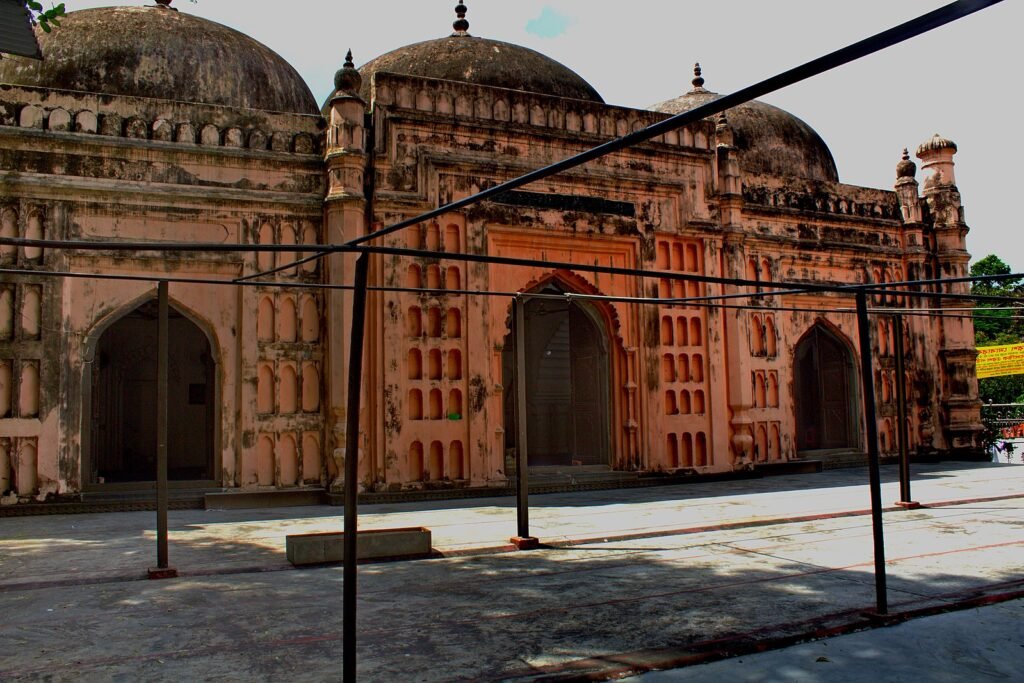Jinn Mosque or Shahbaz Khan Mosque: A Timeless Mughal Gem
Bangladesh stands as a quiet relic of Mughal architecture for instance the Shahbaz Khan Mosque. Built in 1679, this historic mosque, also known as the Khwaja Shahbaz Mosque, and locally called ‘Jinn Masjid’ is one of the oldest surviving Mughal-era structures in the city.
Located near the Dhaka High Court and beside the Mausoleum of the Three Leaders (Teen Netar Mazar), the mosque represents a graceful blend of Islamic architecture, spiritual tradition, and folklore.
Even today, worshippers and tourists visit this serene site, not only for its architectural beauty but also for the mystical tales that surround it.
The History of Shahbaz Khan Mosque
The Shahbaz Khan Mosque was built during the reign of Mughal Emperor Aurangzeb, when Prince Muhammad Azam, the emperor’s son, served as the Subahdar (governor) of Bengal. The mosque was commissioned by Khwaja Shahbaz Khan, a wealthy merchant who held the honorary title “Malik-ut-Tujjar” (meaning “chief merchant”).
Shahbaz Khan was known for his generosity and piety, funding several charitable works in Dhaka. His vision for the mosque was not only to create a place of prayer but also a space that reflected the grandeur and devotion of the Mughal era.
He built the mosque on a slightly raised platform, symbolizing spiritual elevation. Within the same compound lies his tomb, where he was laid to rest after his death.
Architectural Brilliance of the Mughal Era
The architecture of Shahbaz Khan Mosque is a prime example of Bengal’s regional Mughal style, elegant yet compact, ornamented yet solemn. The structure measures about 20.7 meters in length and 7.9 meters in width, featuring three domes, octagonal corner towers, and intricately carved cusped arches.
The eastern façade has three arched entrances, while the north and south walls each feature a single arch. Inside, the three mihrabs (niches indicating the direction of prayer) align perfectly with the outer doorways, a hallmark of Mughal design precision.
The corner minarets rise gracefully, crowned with ribbed cupolas and lotus finials, giving the mosque an appearance of spiritual harmony and balance. Though small in scale compared to imperial mosques like Lalbagh Fort’s mosque, Shahbaz Khan Mosque’s craftsmanship makes it one of Dhaka’s most admired heritage sites.
A Tomb of Reverence
Beside the mosque lies the tomb of Khwaja Shahbaz Khan, enclosed within the same compound. Devotees visit the site to pay respects to the man who helped shape a piece of Dhaka’s spiritual identity over three centuries ago.
The tomb’s simplicity stands in contrast to the mosque’s intricate structure, reflecting Shahbaz Khan’s humility in his final resting place. On Fridays and Islamic holy nights such as Shab-e-Qadr, the area becomes crowded with people offering prayers, reciting the Qur’an, and lighting lamps to honor his legacy.
The Mysterious Tale of the Jinns
One of the most intriguing aspects of the Shahbaz Khan Mosque is the local legend that Jinns, supernatural beings mentioned in Islamic tradition come to pray here.
For generations, residents of old Dhaka have claimed that during the late hours of the night, faint lights can be seen glowing inside the locked mosque, and the soft murmur of prayers can sometimes be heard. Some say the Jinns were once commanded by Shahbaz Khan himself to guard the mosque and continue their worship even after his passing.
Elders recount stories of caretakers who, upon entering the mosque at dawn, found fresh prayer mats slightly moved or a faint fragrance of incense lingering, as though unseen worshippers had just finished their prayers. While these tales are passed on as folklore, they add an undeniable air of mystique to the mosque’s centuries-old presence.
Today, visitors still speak of this legend with curiosity and reverence — a reminder that spiritual spaces in South Asia often intertwine faith and folklore.
Spiritual and Cultural Importance
Beyond the myths, Shahbaz Khan Mosque remains an active place of worship and a symbol of devotion in central Dhaka. Locals visit daily for prayer, and historians regard it as one of the most authentic Mughal mosques still standing in its original form.
Its continued use across generations shows how Islamic heritage in Bangladesh blends seamlessly with urban life. Despite being surrounded by government buildings and modern structures, the mosque maintains an atmosphere of calm and continuity — a link between Dhaka’s past and present.
Preservation and Heritage Efforts
The Bangladesh Department of Archaeology has listed Shahbaz Khan Mosque as a protected heritage site. Conservationists emphasize the need for regular maintenance to preserve its original Mughal detailing, as urban development poses challenges.
Heritage groups have called for improved signage, lighting, and digital documentation so that visitors, both local and international can better appreciate the mosque’s historical and architectural significance.
Given Dhaka’s rapid urbanization, the Shahbaz Khan Mosque stands as a reminder of how heritage conservation can coexist with modernity, preserving the city’s soul amid change.
Visiting Shahbaz Khan Mosque Today
Located near the Dhaka High Court and Shahbagh area, the mosque is easily accessible to both residents and tourists. Visitors are advised to dress modestly and visit during daylight hours, though some choose to stop by in the evening to experience the site’s peaceful aura.
For architecture enthusiasts, this mosque offers insight into how Mughal design adapted to Bengal’s climate and materials — using local bricks, lime mortar, and terracotta detailing. For spiritual visitors, it offers a serene space for reflection and prayer.
A Living Symbol of Dhaka’s Soul
The Shahbaz Khan Mosque is not merely a monument — it is a living chronicle of faith, art, and folklore. From the intricate geometry of its Mughal domes to the whispered tales of Jinns praying in the night, it embodies the enduring connection between the spiritual and the supernatural in South Asian Islamic culture.
As the city around it evolves, the mosque remains steadfast — a timeless guardian of Dhaka’s spiritual heritage and a testament to the vision of one man, Khwaja Shahbaz Khan, whose devotion continues to echo through centuries.
